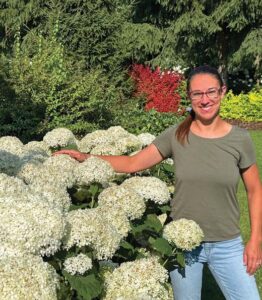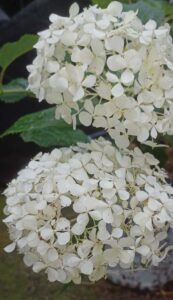
Megan Mathey, breeder of Incrediball ‘Storm Proof’ Photo courtesy of Megan Mathey at springmeadow.com
Garden writers are fortunate to be able to trial plants scheduled for introduction to the public at retail stores in upcoming growing seasons. Our gardens become testing plots or foster homes for plants soon to be adopted by gardeners across USDA hardiness zones.
My latest plant to trial, Hydrangea arborescens, a native smooth hydrangea named Incrediball ‘Storm Proof’™, arrived one month ago via UPS from Proven Winners, a plant brand known for vigorous, disease resistant, and beautiful flowering and remontant annuals, perennials, shrubs, and trees.
The shrub has snowball shaped white flowers. Since this shrub is a smooth hydrangea, flowers do not change color based on the soil’s pH like bigleaf hydrangeas, Hydrangea macrophylla.
Incrediball ‘Storm Proof’ was bred to be a compact hydrangea 3.5–4 feet tall and wide shrub with strong thick flower stems to withstand high winds and heavy rain.
The ancestry of new plant introductions is of interest because breeders decide what characteristics the green industry needs. A distant relative of ‘Storm Proof’ is ‘Annabelle’ hydrangea. ‘Annabelle’ was discovered by chance in the 1960s along a horse path in Anna, Illinois by Dr. Joseph McDaniel, horticulture professor at the University of Illinois. He named the plant ‘Annabelle’ for the women in the town who had grown and shared it with neighbors for years. Annabelle flowers were a mophead version of the native North American smooth hydrangea with large, full, round white flowers. They are used as fresh and dried cut flowers. When introduced, ‘Annabelle’ became an instant classic for the garden. But ‘Annabelle’ had very weak stems, which flop over in high winds and after heavy storms.
In the 21st century plant breeders continue to produce plants with characteristics needed for the home gardener, botanic gardens, and landscape designers. Tim Wood, a plant breeder working at Spring Meadows Nursery in Michigan, set out to create a plant with the fabulously large flowers of ‘Annabelle’ but with improved stem strength and stamina. Wood crossed ‘Annabelle’ with various other Hydrangea arborescens, evaluated thousands of seedlings, and eventually, plants, and selected ‘Incrediball’ in 2009. He had created an improved version of ‘Annabelle’ with strong sturdy stems that don’t flop over and extra-large blooms, nearly the size of basketballs. ‘Incrediball’ is four to five feet tall and wide.
Following in the footsteps of ‘Incrediball’ comes Incrediball ‘Storm Proof,’ a compact variety with impressive bloom count and extra-thick stems built to withstand harsh weather. Megan Mathey, ornamental shrub breeder at Spring Meadows Nursery, is the breeder. She enjoys discovering new plants despite the many trials and tribulations along the way. It can take six to eight years to find the plant traits you are looking for. In every 100 seedlings, she may find five to 10 plants that stand out. It may take much more trialing to find just one plant that stands above all the others. It can take six to eight years to find what you are aiming for.
Incrediball ‘Storm Proof’ will be introduced to the marketplace in 2026 and can be used as a low hedge, edging for a pathway, in cut flower gardens, containers, and pollinator gardens in USDA hardiness zones 3-9.




Loading Comments